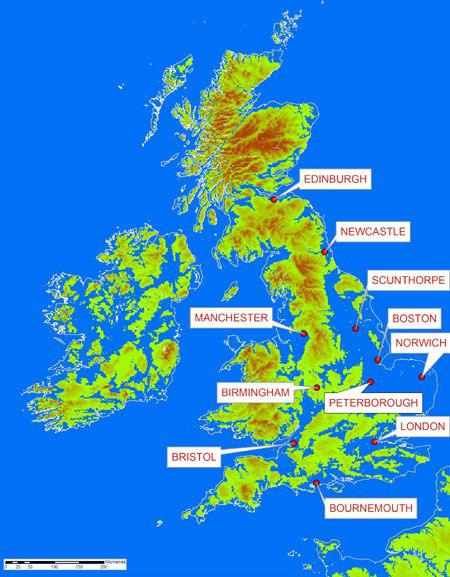By Bill McGuire
If your children or grand children live within sight of the sea, then be afraid. Very afraid. Sea-level rise is set to be one of the most devastating and disruptive consequences of climate breakdown and the prospect of the oceans drowning coastal communities by the end of the century is growing by the day. The prevailing view sees perhaps a metre or so of sea-level rise by the century’s end – enough in its own right to doom low-lying islands and coastlines – but the true picture may be far worse. A number of studies suggest that sea levels by 2100 could be two or three metres up on today; perhaps as much as five metres. A truly terrifying scenario.

How the UK would look on an ice-free Earth
Global sea levels rose by around 20cm during the 20th century and are climbing now at close to half a centimetre a year. Much of this is due to the expansion of the oceans as they warm, but melting ice is playing an ever more important role in hiking the rate of the rise. The problem is that the Earth is not heating up uniformly, and the bad news for us is that temperatures across the polar regions are climbing far more rapidly than anywhere else. Of course, this is where the vast majority of our world’s ice resides; in total, a staggering 24 billion cubic kilometres of it – close to seventy per cent of all the fresh water on Earth. The great ice sheets of Greenland and Antarctica have been bastions of stability since the end of the last Ice Age around 10,000 years ago. During the second half of the 20th century, however, and especially in the last few decades, they have started to crumble, shedding vast quantities of freshwater into the oceans.
Until recently, attention has been focused on accelerating melting of the Greenland and West Antarctic ice sheets, which are the most sensitive to rising temperatures. The last 20 years or so has seen a huge increase in the melting rate of the Greenland Ice Sheet, which is now shedding close to 400 billion tonnes of ice every year. Even more worryingly, the melting rate is increasing exponentially, which means it will continue to accelerate rapidly.
The news from West Antarctica is not good either. In the five years from 2012 to 2017, ice loss from the West Antarctic Ice Sheet shot up threefold, from 76 billion tonnes annually, to a colossal 219 billion tonnes. In total, more than 2.7 trillion tonnes of Antarctic ice has melted in the last quarter century, adding three-quarters of a centimetre to global sea level. At the new rate, the contribution over the next 25 years would be 1.5cm. Not really too much to worry about. If, however, the rate of increase is maintained over this period, then the annual rise by the mid-2040s – barely more than 20 years away – would be close toa catastrophic five centimetres a year. And this is without the growing contribution from Greenland and from the increasing expansion of sea water as the oceans continue to warm. It is not known how the melt rate will change in coming decades, but it is a sobering thought that even if the rate of increase stays as it is, low-lying lands and all coastal population centres would be threatened with permanent inundation by the century’s end.
As if this wasn’t bad enough, new research from East Antarctica paints an even more disturbing picture. The East Antarctic Ice Sheet dwarfs those of both Greenland and West Antarctica. Complete melting of the Greenland Ice Sheet would raise global sea levels by around seven metres, while melting of all the ice in West Antarctica would add another five or so. If East Antarctica lost its ice, however, it would push up sea levels by a staggering fifty metres or more. Until recently, the East Antarctic Ice Sheet was regarded as largely stable, and some studies even suggested that it might have been growing. The new study (1) reveals, however, that this is now changing, and changing with a vengeance. What was a sleeping giant is now beginning to wake up.
Satellite data reveals that a cluster of colossal glaciers, which together make up about an eighth of the coastline of East Antarctica, are starting to melt as the surrounding ocean gets progressively warmer. The loss of the giant (It’s about the size of Spain!) Totten Glacier – just one of the cluster – would, on its own, raise global sea levels by more than three metres. The new data show that it and its companions are now moving increasingly rapidly seawards and thinning as they do so, meaning that even the worst predictions for rising sea levels may be optimistic. As with the many other indicators that flag the remorseless breakdown of the stable climate that fostered the growth of our civilisation, the collapse of the polar ice sheets sends us the message that time has run out. Prevarication is no longer an option. Only serious and determined action now will give us any chance of avoiding a climate calamity that will swamp the world’s coastlines and displace hundreds of millions – if not billions – of people.
(1)
Bill McGuire is Professor Emeritus of Geophysical & Climate Hazards at UCL and author of Waking the Giant: How a Changing Climate Triggers Earthquakes, Tsunamis and Volcanic Eruptions. He was a contributor to the IPCC 2012 report on Climate Change &Extreme Events and Disasters.





